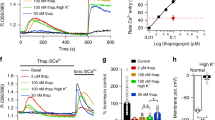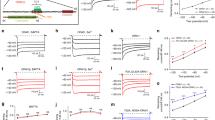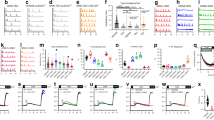Abstract
Receptor-evoked Ca2+ signalling involves Ca2+ release from the endoplasmic reticulum, followed by Ca2+ influx across the plasma membrane1. Ca2+ influx is essential for many cellular functions, from secretion to transcription, and is mediated by Ca2+-release activated Ca2+ (Icrac) channels and store-operated calcium entry (SOC) channels2. Although the molecular identity and regulation of Icrac and SOC channels have not been precisely determined1, notable recent findings are the identification of STIM1, which has been indicated to regulate SOC and Icrac channels by functioning as an endoplasmic reticulum Ca2+ sensor3,4,5,6, and ORAI1 (ref. 7) or CRACM1 (ref. 8) — both of which may function as Icrac channels or as an Icrac subunit. How STIM1 activates the Ca2+ influx channels and whether STIM1 contributes to the channel pore remains unknown. Here, we identify the structural features that are essential for STIM1-dependent activation of SOC and Icrac channels, and demonstrate that they are identical to those involved in the binding and activation of TRPC1. Notably, the cytosolic carboxyl terminus of STIM1 is sufficient to activate SOC, Icrac and TRPC1 channels even when native STIM1 is depleted by small interfering RNA. Activity of STIM1 requires an ERM domain, which mediates the selective binding of STIM1 to TRPC1, 2 and 4, but not to TRPC3, 6 or 7, and a cationic lysine-rich region, which is essential for gating of TRPC1. Deletion of either region in the constitutively active STIM1D76A yields dominant-negative mutants that block native SOC channels, expressed TRPC1 in HEK293 cells and Icrac in Jurkat cells. These observations implicate STIM1 as a key regulator of activity rather than a channel component, and reveal similar regulation of SOC, Icrac and TRPC channel activation by STIM1.
This is a preview of subscription content, access via your institution
Access options
Subscribe to this journal
Receive 12 print issues and online access
$209.00 per year
only $17.42 per issue
Buy this article
- Purchase on Springer Link
- Instant access to full article PDF
Prices may be subject to local taxes which are calculated during checkout





Similar content being viewed by others
Accession codes
Accessions
GenBank/EMBL/DDBJ
References
Parekh, A. B. & Putney, J. W., Jr. Store-operated calcium channels. Physiol. Rev. 85, 757–810 (2005).
Berridge, M. J., Bootman, M. D. & Roderick, H. L. Calcium signalling: dynamics, homeostasis and remodelling. Nature Rev. Mol. Cell Biol. 4, 517–529 (2003).
Spassova, M. A. et al. STIM1 has a plasma membrane role in the activation of store-operated Ca2+ channels. Proc. Natl Acad. Sci. USA 103, 4040–4045 (2006).
Zhang, S. L. et al. STIM1 is a Ca2+ sensor that activates CRAC channels and migrates from the Ca2+ store to the plasma membrane. Nature 437, 902–905 (2005).
Roos, J. et al. STIM1, an essential and conserved component of store-operated Ca2+ channel function. J. Cell Biol. 169, 435–445 (2005).
Liou, J. et al. STIM is a Ca2+ sensor essential for Ca2+-store-depletion-triggered Ca2+ influx. Curr. Biol. 15, 1235–1241 (2005).
Feske, S. et al. A mutation in Orai1 causes immune deficiency by abrogating CRAC channel function. Nature 441, 179–186 (2006).
Vig, M. et al. CRACM1 is a plasma membrane protein essential for store-operated Ca2+ entry. Science 312, 1220–1223 (2006).
Williams, R. T. et al. Identification and characterization of the STIM (stromal interaction molecule) gene family: coding for a novel class of transmembrane proteins. Biochem. J. 357, 673–685 (2001).
Crabtree, G. R. & Olson, E. N. NFAT signaling: choreographing the social lives of cells. Cell 109 (Suppl.), S67–S79 (2002).
Freichel, M. et al. Functional role of TRPC proteins in native systems: implications from knockout and knock-down studies. J. Physiol. 567, 59–66 (2005).
Lintschinger, B. et al. Coassembly of Trp1 and Trp3 proteins generates diacylglycerol- and Ca2+-sensitive cation channels. J. Biol. Chem. 275, 27799–27805 (2000).
Northrop, J. P., Ullman, K. S. & Crabtree, G. R. Characterization of the nuclear and cytoplasmic components of the lymphoid-specific nuclear factor of activated T cells (NFAT) complex. J. Biol. Chem. 268, 2917–2923 (1993).
Northrop, J. P. et al. NFAT components define a family of transcription factors targeted in T-cell activation. Nature 369, 497–502 (1994).
Tsai, R. Y. & Reed, R. R. Using a eukaryotic GST fusion vector for proteins difficult to express in E. coli. Biotechniques 23, 794–796, 798, 800 (1997).
Sun, L. et al. Cabin 1, a negative regulator for calcineurin signaling in T lymphocytes. Immunity 8, 703–711 (1998).
Yuan, J. P. et al. Homer binds TRPC family channels and is required for gating of TRPC1 by IP3 receptors. Cell 114, 777–789 (2003).
Xiao, B. et al. Homer regulates the association of group 1 metabotropic glutamate receptors with multivalent complexes of homer-related, synaptic proteins. Neuron 21, 707–716 (1998).
Kozak, J. A., Kerschbaum, H. H. & Cahalan, M. D. Distinct properties of CRAC and MIC channels in RBL cells. J. Gen. Physiol. 120, 221–235 (2002).
Acknowledgements
We thank J. Liu (Johns Hopkins University) for the plasmids NFAT1–GFP (HA–mNFAT1(1–460)–GFP), pNFAT-luc, pAP1-luc and pSV40-β-galactosidase; and T. Meyer (Stanford University) for the plasmid YFP–STIM1. Research was supported by grants from the National Institute on Drug Abuse (NIDA; DA00266, DA10309) and the National Institute of Mental Health (NIMH; MH068830) to P.F.W., and the National Institute of Dental and Craniofacial Research (NIDCR) and National Institute of Diabetes, Digestive and Kidney Diseases (NIDDK) to S.M.
Author information
Authors and Affiliations
Corresponding authors
Ethics declarations
Competing interests
The authors declare no competing financial interests.
Supplementary information
Supplementary Information
Supplementary Figures S1, S2, S3 and S4 (PDF 672 kb)
Rights and permissions
About this article
Cite this article
Huang, G., Zeng, W., Kim, J. et al. STIM1 carboxyl-terminus activates native SOC, Icrac and TRPC1 channels. Nat Cell Biol 8, 1003–1010 (2006). https://doi.org/10.1038/ncb1454
Received:
Accepted:
Published:
Issue Date:
DOI: https://doi.org/10.1038/ncb1454
This article is cited by
-
Neuronal Store-Operated Calcium Channels
Molecular Neurobiology (2023)
-
Paraquat is an agonist of STIM1 and increases intracellular calcium levels
Communications Biology (2022)
-
STIM-Orai1 signaling regulates fluidity of cytoplasm during membrane blebbing
Nature Communications (2021)
-
TRPC1 mediates slow excitatory synaptic transmission in hippocampal oriens/alveus interneurons
Molecular Brain (2020)



